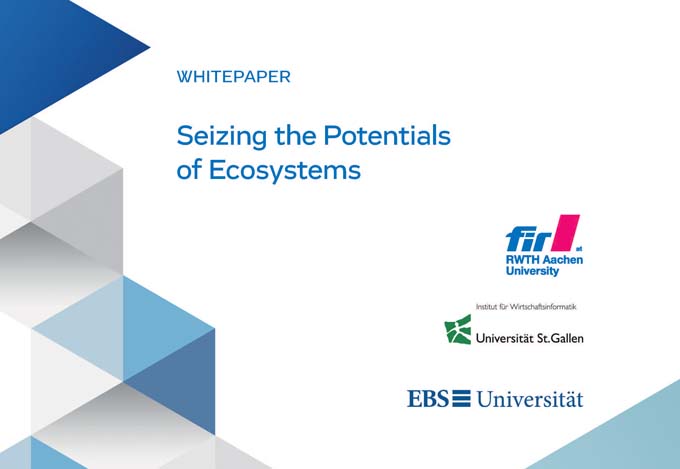Whitepaper "Seizing the Potentials of Business Ecosystems".
EBS, FIR and University of St. Gallen publish recommendations for value-adding collaboration in ecosystems, derived from the latest scientific findings.

The joint white paper "Seizing the Potentials of Ecosystems" by researchers from EBS Universität für Wirtschaft und Recht, FIR at RWTH Aachen University, and the University of St. Gallen presents the core characteristics of business ecosystems based on the latest research findings and best practices. The team derives recommendations for sustainable competitive advantages.
Ecosystems as forms of value creation
Ecosystems represent new forms of value creation across company and industry boundaries. They are emerging in all industries and form the basis for the most valuable companies. Between 2015 and 2021, for example, 23% of all startups rated as "Unicorn" (i.e., valued at more than 1 billion $) had their business model significantly aligned with ecosystem value creation. At the same time, 22 of the S&P (Standard & Poor's.) Top 100 companies operated significantly in ecosystems, representing 40% of the S&P Top 100 market capitalization.*)
White paper explains nine core properties
Successful companies are proving that both customers and companies benefit from ecosystems. The enormous potential for value creation is arousing massive interest in this new form of business, but there is often a lack of common understanding of what ecosystems actually are and can achieve. An interdisciplinary team of researchers has therefore characterized the nature of ecosystems on the basis of three levels and a total of nine core properties:
Ecosystem Core
- Shared purpose and vision
- Co-creation between stakeholders involved
- Modular, complementary solutions
Ecosystem Relationships
- Multilateral relations
- Autonomous actors
- Information-based value creation
Ecosystem environment
- Shared values
- Common technological infrastructure
- Network effects
Based on this classification, the research team provides concrete recommendations in the white paper for achieving sustainable competitive advantages in the technological, social and economic environment in ecosystems. Best practices from experienced managers from established industrial companies and digital startups illustrate how the core characteristics of ecosystems are put into practice. The whitepaper is available at seizing-ecosystems.fir.com/white-paper/ available for download free of charge.









